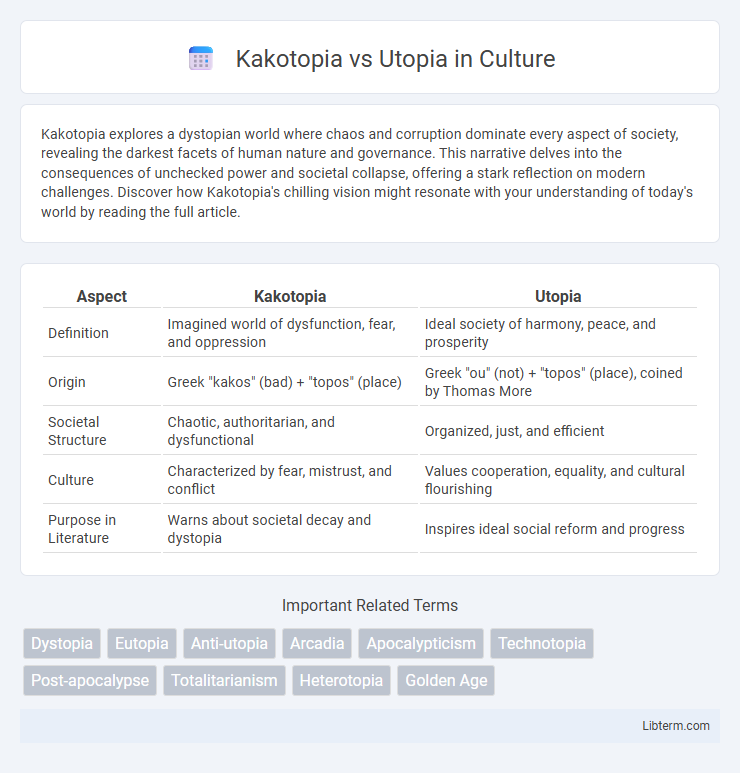Kakotopia explores a dystopian world where chaos and corruption dominate every aspect of society, revealing the darkest facets of human nature and governance. This narrative delves into the consequences of unchecked power and societal collapse, offering a stark reflection on modern challenges. Discover how Kakotopia's chilling vision might resonate with your understanding of today's world by reading the full article.
Table of Comparison
| Aspect | Kakotopia | Utopia |
|---|---|---|
| Definition | Imagined world of dysfunction, fear, and oppression | Ideal society of harmony, peace, and prosperity |
| Origin | Greek "kakos" (bad) + "topos" (place) | Greek "ou" (not) + "topos" (place), coined by Thomas More |
| Societal Structure | Chaotic, authoritarian, and dysfunctional | Organized, just, and efficient |
| Culture | Characterized by fear, mistrust, and conflict | Values cooperation, equality, and cultural flourishing |
| Purpose in Literature | Warns about societal decay and dystopia | Inspires ideal social reform and progress |
Defining Utopia: The Ideal Society
Utopia represents the ideal society characterized by perfect harmony, justice, and abundance, embodying an aspirational vision where all citizens experience equitable well-being and fulfillment. In contrast, Kakotopia depicts a dystopian reality marked by chaos, suffering, and systemic dysfunction, highlighting the failure to achieve societal ideals. Defining Utopia involves envisioning a balanced socio-political structure that ensures universal happiness, ethical governance, and sustainable prosperity.
Understanding Kakotopia: The Dystopian Reality
Kakotopia represents a dystopian reality characterized by chaos, oppression, and societal decay, contrasting sharply with the idealized harmony of Utopia. This concept highlights the dangers of failed governance, environmental collapse, and systemic injustice, revealing the harsh consequences of a broken society. Exploring Kakotopia offers critical insights into the fragility of social order and the importance of sustainable, equitable structures for human well-being.
Historical Origins of Utopian and Kakotopian Concepts
Utopian concepts trace back to Plato's "Republic" and Thomas More's 1516 work "Utopia," envisioning ideal societies with perfect political and social systems. Kakotopia, or dystopia, emerged as a critical response in literature and philosophy, depicting societies marked by oppression, totalitarian rule, and social injustice, with roots in works like Jonathan Swift's "Gulliver's Travels" and George Orwell's "1984." These contrasting concepts reflect evolving human critiques of society, governance, and the pursuit of idealism throughout history.
Literature’s Role in Shaping Utopia and Kakotopia
Literature plays a crucial role in shaping perceptions of utopia and kakotopia by exploring idealized worlds and dystopian realities that reflect societal aspirations and anxieties. Through narrative and symbolism, literary works construct visions of perfect societies (utopias) or nightmarish ones (kakotopias), influencing cultural and political discourse on human potential and governance. The imaginative power of literature enables critical examination and reinterpretation of societal values, driving the evolution of utopian and kakotopian thought.
Philosophical Theories Behind Utopia and Kakotopia
Utopia represents an ideal society based on philosophical theories of perfect justice, equality, and harmony, as envisioned by thinkers like Plato and Thomas More, emphasizing the potential for human reason to create flawless social order. Kakotopia, derived from Greek meaning "bad place," critiques utopian ideals by highlighting inherent flaws in human nature and social systems, as emphasized by dystopian philosophers such as Hobbes and Orwell, who argue that attempts at perfection can lead to oppression and chaos. This contrast reflects ongoing debates in political philosophy about idealism versus realism in designing societies.
Key Features of Utopian Societies
Utopian societies are characterized by idealized social structures promoting equality, justice, and harmony, where resources are distributed fairly to ensure everyone's well-being. Key features include transparent governance, sustainable environmental practices, and a collective emphasis on education and personal development. Unlike Kakotopia, which highlights dysfunction and chaos, Utopias envision a perfectly ordered society that maximizes happiness and minimizes conflict.
Core Elements of Kakotopian Worlds
Kakotopian worlds are defined by pervasive chaos, systemic dysfunction, and oppressive social structures that highlight human suffering and moral decay. Central elements include a breakdown of order, corrupt governance, and environments where fear and violence pervade daily life, contrasting starkly with utopian ideals of harmony and perfection. These core aspects emphasize existential dread and the consequences of failed societal constructs, forming a grim mirror to utopian aspirations.
Lessons from Real-World Attempts at Utopia
Kakotopia and utopia both explore ideal societies, but real-world attempts at utopia often reveal kakotopian outcomes due to impractical ideals and human complexity. Historical examples like communal experiments in the 19th century demonstrate that rigid utopian visions frequently lead to social dysfunction, economic failure, and authoritarianism. Lessons from these experiments highlight the importance of flexibility, inclusivity, and realistic governance in any pursuit of a perfect society.
Population Perceptions: Hope vs Fear
Kakotopia represents a societal perception dominated by fear, where population concerns center on chaos, instability, and the erosion of trust in governance. In contrast, Utopia embodies hope, reflecting collective aspirations for harmony, equity, and sustainable growth within a population. These divergent perceptions significantly influence social behaviors and policy support, shaping the future trajectories of communities.
The Relevance of Utopia and Kakotopia in Modern Society
Kakotopia and Utopia offer contrasting frameworks that critically shape modern societal visions by highlighting potential dystopian failures and idealistic aspirations. The relevance of Utopia in contemporary discourse lies in its role as a blueprint for achievable social progress, inspiring policies aimed at equality, sustainability, and technological innovation. Kakotopia serves as a cautionary paradigm, emphasizing the risks of unchecked power, environmental degradation, and social fragmentation, thus fostering vigilant governance and ethical responsibility.
Kakotopia Infographic

 libterm.com
libterm.com